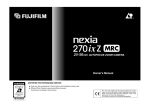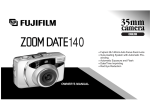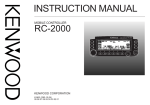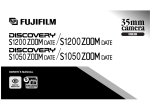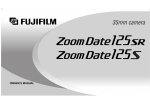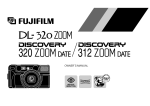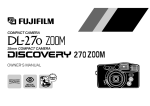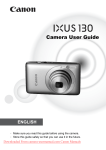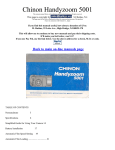Download FujiFilm 16421555 Digital Camera User Manual
Transcript
Owner’s Manual CERTIFIED PHOTOFINISHING SERVICE ● Have your film processed by a Photo Finisher which displays the above sign. ● Different Photo Finishers may provide different services. Consult them for details of their services. The “CE” mark certifies that this product satisfies the requirements of the EU (European Union) regarding safety, public health, environment and consumer protection. (“CE” is the abbreviation of Conformité Euroéepnne.) This product conforms with Directive 89/336/EEC. CONTENTS FEATURES . . . . . . . . . . . . . . . . . . . . . . . . . . . . . . . PART NAMES . . . . . . . . . . . . . . . . . . . . . . . . . . . . . USING THE SELF-TIMER . . . . . . . . . . . . . . . . 35 2 3 USING THE REMOTE CONTROLLER . . . . 37 MULTI PROGRAM FLASH . . . . . . . . . . . . . . . . CAMERA CARE AND CAUTIONS . . . . . . . . . ERRORS, POSSIBLE CAUSES, AND REMEDIES . . SPECIFICATIONS . . . . . . . . . . . . . . . . . . . . . . . 1. PRELIMINARY STEPS ATTACHING THE STRAP . . . . . . . . . . . . . . . . . 5 LOADING THE BATTERY . . . . . . . . . . . . . . . . 6 POWER ON/OFF . . . . . . . . . . . . . . . . . . . . . . . . 7 SETTING AND CORRECTING THE DATE (YEAR : MONTH : DAY/HOUR : MINUTE) . . . . . 8 SELECTING THE DATE MODE . . . . . . . . . . . 10 FEATURES • • • • • • • Autofocus 23-70mm Zoom Mid-Roll Change Super EBC Fujinon Lens Multi-Programmed Retractable Flash Error-Free Drop-in Loading 3 Selectable Prints Formats Print Quality Enhancement Through Information Exchange System • Date or Time Printing Capability • Red Eye Reductoin 2. BASIC PROCEDURES LOADING THE FILM CARTRIDGE . . . . . . . . . SELECTING THE PRINT FORMAT . . . . . . . . TAKING PICTURES . . . . . . . . . . . . . . . . . . . . . USING THE AUTO-FOCUS LOCK . . . . . . . . . UNLOADING THE FILM CARTRIDGE . . . . . . 40 42 43 45 11 14 17 21 23 CARTRIDGE MID-ROLL CHANGE FUNCTION . . . . . . . . . . . . . . . . . . . . . . . . . . 25 3. ADVANCED TECHNIQUES SELECTING THE EXPOSURE MODE . . . . . . . 30 2 PART NAMES q (See the illustrations while you read this manual.) y !1 !7 u !2 e r !8 !3 w i !9 @0 !4 o !5 @1 !0 !6 @2 t @3 q w e r t y u i o !0 !1 !2 !3 !4 !5 !6 !7 !8 !9 @0 @1 @2 @3 Shutter Release Button AE Light Sensor Viewfinder Window Film Cartridge Compartment Cover Release Knob Strap Lug AF (Autofocus) Window Flash Remote Control Sensor Self-Timer/Remote Controller Lamp Super EBC Fujinon Lens Viewfinder Eye-piece Battery Compartment Cover 3 AF Lamp Liquid Crystal Display Exposure Mode Button Self-timer/Remote Control/Date Set Button Format Selector Zoom Lever DATE Button Mid-Roll Change Button Power Button Film Cartridge Compartment Cover Tripod Socket Liquid crystal display @5 @6 @7 @4 #3 @8 #2 #1 @9 #0 Liquid Crystal Display The diagram shows all crystal displays in the “on” state. @4 @5 @6 @7 @8 @9 #0 #1 #2 #3 Red-eye Reduction Flash Mode Fill-in Flash Mode/Flash off Mode Landscape Mode Night Portrait Mode Battery Capacity Date Display (Type of Film Cartridge/Camera ISO Display) Exposure Counter/Self-timer Count Film Cartridge Mark Remote-Control Mode Sign Self-Timer Mode 4 1. PRELIMINARY STEPS ATTACHING THE STRAP Fig. 1 Pass the smaller loop end of the strap through the camera’s strap lug. Fig. 2 Next, pass the longer loop end of the strap through the smaller loop, and pull the longer loop end. 5 LOADING THE BATTERY Use the following lithium battery. ★ (One) 3V lithium battery. CR2/DL CR2 or equivalent. ✻ One lithium batter y has enough power for taking approximately 300 shots (Based on our test conditions). ✻ If many rolls of Film are used, when travelling, for example, it is desirable to take spare batteries (particular in areas where it may be difficult to obtain batteries). q w Fig. 3 Open the battery cover in the arrow direction as shown in the figure. Fig. 4 Inser t the batteries straight as shown in the indications so that they are not at a slant, then close the battery cover. ✻ After changing the battery, be sure to set the date again. (The method for setting the date is shown on Fig.8) 6 Fig. 5 Check the battery capacity sign on the Liquid Crystal Display. q on: Battery capacity is OK. w on: Battery capacity is insufficient; provide a new battery. e blink: Shutter release will not trip because the battery has no charge; change the battery. ✻ Check the battery capacity sign before using the camera. ✻ The battery can be replaced even when there is a film cartridge in the camera. POWER ON/OFF Fig. 6 Press the power supply button to turn on the power, Pressing the button once again turns the power supply off. ✻ When the power supply is left on for more than 5 minutes without use, the power tur ns off automatically. 7 Fig. 7 When the power is turned on, the lens cover opens, the lens unit extends toward the front and the flash unit pops up, setting the camera in a condition where it is ready to take pictures. ✻ Do not restrict the motion of the lens cover with your fingers when you turn the power on. Doing so could cause the camera to malfunction. SETTING AND CORRECTING THE DATE (YEAR:MONTH:DAY/HOUR:MINUTE) Fig. 8 Turn on the power, then press the DATE button continuously for 2 seconds or longer. This will cause the Year display to blink and the camera will enter the date setting mode. Adjustable items are as follows. Year : Month : Hour : 8 ’98 – ’29 (1998 – 2029) 1 – 12 Day : 1 – 31 0 – 23 Minute : 00 – 59 Fig. 9 Press the DATE button to select the next number blinking in the order Year → Month → Day → Hour → Minute. Press the r button q to correct the numerals blinking in the liquid crystal display. If you press the DATE button w at this time, the blinking numerals to be corrected will change in sequence from Year → Day → Hours → Minutes. Fig. 10 Press the DATE button after correcting the year, month, day, hour and minutes to complete the date correction procedure. w q ✻ To set the hour or minute by the radio, press the DATE Button when the time signal announces zero. ✻ The year, month, and day change together with the hour and minute. 9 SELECTING THE DATE MODE With the Advanced Photo System Fig. 11 The date (year/month/day, hour/minute) can be printed on the front and back of the print. Frontprinting, which can be seen when inserted in an album, and backprinting, which is convenient for cataloging. Either can be used depending on the purpose. 99. 7. 24 ✻ Some photo finishers may not support the feature for printing on the surface. ✻ Changes, such as eliminating the date, are possible when re-printing. (Some photo finisher's may not support this feature.) Fig. 12 Switch on the power and press the DATE Button to enable selection of the date mode. The mode display will be recorded during exposure and printed during processing. ✻ With some backgrounds, the date display on the front may be difficult to see. ✻ The front print surface will not be printed when “- - - - - - ” is displayed. The date (Year, Month, Day) will be printed on the rear surface. 10 Fig. 13 Y M D M D Y D M Y The date mode will alter nate as shown in the diagram whenever the DATE Button is pressed. ✻ The date mode will be displayed in the [Year, Month, Day] sequence when the date is realigned even when a date mode other than [Year, Month, Day] has been selected. Select the date mode every time the date has been realigned if a setting other than [Year, Month, Day] is required. (Y : Year M : Month D : Day T : Time) T 2. BASIC PROCEDURES LOADING THE FILM CARTRIDGE 1 With the Advanced Photo System Fig. 14 IX240 cartridge film is used. 2 3 4 ✻ Confirm that the i sign or j sign on the film cartridge is white. Cartridges in which the k and l signs are white cannot be used. (Optical Double Exposure Prevention.) (1 unexposed 2 partial 3 exposed 4 processed) 11 Fig. 15 ✻ If H and “ B ” are lit on the Liquid Crystal Display, your camera contains a film cartridge already exposed. Remove the film cartridge, following the instructions on page 23. A Fig. 16 q Make sure that the film cartridge mark H is not displayed in area A of the Liquid Crystal Display. Move the car tridge cover released knob in the direction of q and open the cartridge cover slightly. Open the cartridge cover in the direction of w. ✻ Do not apply unnecessar y force to the film cartridge compartment cover. w 12 w q Fig. 17 Drop the cartridge q into place and then close the cartridge cover w. ✻ Inser t the batter y before inser ting the film cartridge. A B Fig. 18 When the film car tridge compar tment cover is closed, the film advances automatically to the first frame. ✻ The camera ISO B and the type of film cartridge A will appear in the Liquid Crystal Display until the first frame is set. Type of film cartridge Color Negative Positive Black and White Other m o No display 13 n Fig. 19 When the first frame of the film is set, the usable number of frames (specified number of exposures in the film) is displayed in the exposure counter. ✻ The number indicated in the exposure counter decreases by one each time a picture is taken. SELECTING THE PRINT FORMAT With the Advanced Photo System Three print formats - C, H and P can be chosen. Press in the Print Format Button to select the format you want. Fig. 20 Select the print format with the print format switch located on the rear of the camera. 14 Fig. 21 The view through the finder will change to the style of photographs shown when the print format switch is operated. The angle of the exposure will not change. A : C Print (2 : 3) B : H Print (9 : 16) C : P Print (1 : 3) ✻ Figures in ( 15 ) represent the aspect ratio. A Fig. 22 Near-distance exposure The area visible in the part shown will be printed when an exposure closer than approximately 1.5m is taken. As the area visible through the finder and the area actually exposed will differ with near-distance exposures (owing to the positions of the finder and the exposure lens being different), correcting the visible range through the finder with the neardistance correction mark provides a useful yardstick for the area actually exposed. ● (A : Parallax correction mark) 16 Fig. 23 H&P C H&C P Even when anyone of the C/H/P print format has been selected, the size of the photograph on the film remains the same (approx. 17 x 30mm). Print format selection will record the print format for each frame and the exposure will be printed within the ranges shown in the above illustrations. ✻ The print format can be changed when reprinting. C H P 16 x 23 mm 16 x 28 mm 10 x 28 mm TAKING PICTURES Fig. 24 Hold the camera firmly with both hands. When holding vertically, keep the flash lamp upward. Take a test exposure prior to taking important photographs (weddings, overseas travel, businessrelated, etc.,) to ensure that the camera is functioning correctly. 17 Fig. 25 Ensure that fingers or the camera strap are not obscuring the lens of flash assembly. Fig. 26 Press the zoom lever T mark until the required level of zoom has been acquired when the subject is to be magnified. Press the W mark to obtain the wideangle zoom. ✻ The minimum distance for exposure is 0.6 m. 18 Fig. 27 Aim at the subject so that it fills the whole AF frame. (A : AF (Autofocus) frame) A Fig. 28 When the shutter release button is pressed halfway and the AF lamp (green) turns on, focusing is complete. ✻ While the shutter release button is pressed halfway, the film speed and Type of film is indicated in the Liquid Crystal Display. ✻ When you are too close to the subject, the AF lamp (green) will start blinking. ✻ Note that when you are closer than about 30 cm, the AF lamp turns on but focusing will not be sharp. 19 Fig. 29 When the shutter trips, the flash fires and the film advances to the next frame. ✻ For bright remote scenes, the flash does not fire. ✻ The AF lamp will go off once and reappear immediately after the shutter is released. ✻ During the charging time of the flash (when the alarm sign is blinking c) the shutter cannot be released. ● In dark places, photos should be taken within the following flash lamp ranges. Effective flash lamp range Film speed Wide angle (23mm) Telephoto (70mm) ISO 100 0.6 ~ 3.2 0.6 ~ 1.9 ISO 200 0.6 ~ 4.5 0.6 ~ 2.7 ISO 400 0.6 ~ 6.3 0.6 ~ 3.8 (Using color negative film; units; m) 20 In the following cases, the camera may not be able to focus on the subject. Such subjects must be shot using the “AF-lock” or “Landscape Mode”. (refer to pages 21 and 33) q A bright light source such as the sun is near the subject or there is reflected light (from the windscreen of a vehicle, waves, etc.) near the subject. w When shooting black light-absorbing subjects such as hair. e A mirror or light-reflecting surfaces such as metals are near the center of the picture. r There are gaseous substances such as flame or smoke. t Taking pictures through glass. ● USING THE AUTO-FOCUS LOCK Fig. 30 In the composition shown above, the AF frame is off the subject (in this case, the people). In this state the lens will not focus on the subject. 21 Fig. 31 Move the camera slightly so that the subject is inside the AF frame. Fig. 32 Press the shutter release button halfway down and confirm that the AF lamp lights without moving the camera. (Focus is locked on your subject in this condition.) 22 Fig. 33 While holding the shutter release button halfway down to keep the Auto-Focus lock on, move the camera back to the original position to recompose your picture, then press the shutter release button all the way down. ✻ The Auto-Focus lock operation can be repeated any number of times before the shutter trips. UNLOADING THE FILM CARTRIDGE Fig. 34 When the last frame has been exposed, the film is rewound. The exposure counter shows the number of frames remaining after subtracting the exposed frames from the specified number of frames. ✻ When rewinding of the film is finished, an “ sign will appear in the exposure counter. 23 B ” Fig. 35 q When the exposure counter shows “ B ” and the motor stops, move the film cartridge compartment cover release knob as indicated in q, in the direction indicated in w, and open the film car tridge compartment cover. ✻ Always make sure that the motor is stopped and “ B ” is displayed before moving the film cartridge opening knob. Otherwise, camera trouble or accidental exposure of the film may occur. w Fig. 36 Take out the film car tridge after opening the cartridge compartment cover. ✻ “ k ” is displayed on the cartridge. ✻ Do not apply unnecessary force to the cartridge compartment cover. 24 Fig. 37 Press the Mid-Roll Change Button to rewind the film when the cartridge is to be ejected in the middle of the roll. Do not remove the cartridge until “ B ” is displayed in the exposure counter and the rewind motor has ceased to operate. ✻ When rewinding a roll of film which is only partially exposed. Refer to CARTRIDGE MID-ROLL CHANGE FUNCTION. CARTRIDGE MID-ROLL CHANGE FUNCTION With the Advanced Photo System Fig. 38 The cartridge can be replaced even in mid-roll. This convenient feature makes it possible for family members to alternate using one camera, to keep hobby pictures separate from photographs for work, and to interchange cartridges with different film speeds. 25 Fig. 39 Fig. 40 q w Press in the Mid-Roll Change Button. The film counter will display as it subtracts from the number of frames. When rewinding is completed, “ B ” will be displayed by the film counter. When “ B ” appears in the film counter and the motor has stopped, raise the cartridge compartment cover release knob as shown in illustration q, move it in the direction shown in illustration w and open the cartridge compartment cover. The number of unexposed frames will be displayed by the film counter at this time. 26 Fig. 41 2 A Remove the cartridge and sign sure the sign j appears white. (A: Film cartridge with unexposed frames) Fig. 42 Load a new film cartridge (with a white i cartridge status mark). The film will be advanced to the first frame, and number of exposures specified on the film cartridge will appear in the LCD. 27 Fig. 43 When a cartridge that was removed in mid-roll j is re-loaded, the film will automatically be advanced to the first unexposed frame. After that, operation is as before. ✻ Even if you forget how many frames were exposed on a cartridge that was removed in mid-roll, just re-load the car tridge. The camera will automatically set the remaining number of unexposed frames and display that number on the Liquid Crystal Display. ◆ Cautions Concerning the Mid-roll Change Function ✻ When a cartridge that has been removed in mid-roll ( j is displayed) is re-loaded into the camera, if “ B ” blinks in the film counter, re-load the cartridge once more, avoiding the following locations. • Anywhere near a drier, fan, vacuum cleaner, etc., which has a rotating motor. • Near an active TV or personal computer display. ✻ If a cartridge is removed in mid-roll j and then loaded into a camera which does not have the mid-roll change function, the cartridge will be set to exposed k and can no longer be used. 28 ✻ A cartridge removed in mid-roll k from a camera which does not have the Mid-Roll Change function cannot be used even if loaded into this camera. ✻ If a cartridge is removed in mid-roll j and sent to the processor, all frames on the entire roll will be developed. Expose all frames on the roll before sending the cartridge to the processor for development. ✻ The mid-way replacement of cartridges is only guaranteed with [ENDEAVOR/FOTONEX] cameras equipped with the MRC function manufactured by Fuji Film. There are cases where normal operations are not possible when cartridges containing frames exposed by MRC cameras manufactured by other companies are used. 29 3. ADVANCED TECHNIQUES SELECTING THE EXPOSURE MODE Fig. 44 Your camera has six exposure modes so that you can enjoy photography in response to various subjects. These modes are: ( ) Multi program flash mode (b) Red-eye reduction flash mode ( c ) Back light compensation flash mode (d ) Flash off mode (e ) Landscape mode ( ) Night portrait (slow sync) mode Each time you press in the Mode button, mode signs will appear in the LCD in the order of ( ), (b), (c), (d), (e), ( ). The finally displayed mode will be selected. No display : Multi program flash mode Fig. 45 Used during normal exposures The amount of flash released will be automatically adjusted in accordance with the brightness, distance and magnification of the subject. ✻ The flash lamp does not fire for bright longdistance scenes. ✻ Refer to page 40 for further details on the Multi Program flash. 30 Fig. 46 b : Red-eye reduction flash mode Reduces red-eye The flash lamp will fire briefly five times (pre-flash), then fire the sixth time for taking your picture. ✻ The AF lamp sign in the viewfinder eyepiece stays on from pre-flash to exposure. Do not move the camera while the AF lamp is on. About red-eye When a person is photographed with flash in dim light, the eyes will sometimes turn out red. This is because the light from the flash lamp is reflected back into the lens from the back (retina) of the person’s eyes. In addition to using the red-eye reduction mode, observance of the following is effective in reducing red-eye. ● q Have the person being photographed look directly at the camera lens. wTake pictures by approaching as close as possible to the subject. 31 Fig. 47 c : Fill-in flash mode Used when photographing from windows, in the shade of trees and for other backlit exposures. Takes flash exposures even in bright locations. Fig. 48 d : Flash Off mode Use when taking pictures using interior light or for taking distant subjects which the flash lamp light cannot reach, such as in a theater or stadium. The flash lamp will not flash. ✻ When taking a picture in dim light in the Fill-in flash mode, a tripod should be used to avoid camera shake. 32 Fig. 49 e : Landscape mode This is used for taking clear landscape pictures or photographing remote (night) scenes through glass. Set the focus in the distance. The flash will not operate. ✻ This feature will be canceled after every exposure. ✻ When taking pictures in dim light in the landscape mode, a tripod should be used to avoid camera shake. : Night portrait (slow sync) mode Fig. 50 This is used for taking photographs of people at night The camera will enter the slow-shutter red-eye reduction mode (flash emitted after five pre-flashes) to enable the clear exposure of both night scenes and human subjects. 33 ✻ This feature will be canceled after every exposure. ✻ As a slow shutter speed is used with the night portrait mode, ensure that a tripod is used to prevent camera-shake. It is also important that the subject remains motionless dur ing the exposure. ✻ The daylight flash mode, the Fill-in flash mode, and landscape mode and the night portrait (slow shutter) mode will be canceled when the power is switched off. • To enable the continual use of the landscape mode and night scene portrait mode, press the Exposure mode button for two or more consecutive seconds when selecting the mode until the mark changes from being illuminated to blinking. The mode will then remain in place after exposure to enable continual use. This feature will be canceled automatically when the power is switched off. 34 USING THE SELF-TIMER Fig. 51 Press the r button to show on the Liquid Crystal Display the self-timer symbol r and the number of shots you selected. Press it as many times as you want to shoot with the self-timer (up to three shots). ✻ Fig. 52 is the remote control mode. Refer to Fig.54 to Fig.59 further details. When the shutter release is depressed, the camera focuses on the subject in the AF frame and the selftimer starts. 35 Fig. 53 The self-timer lamp will begin to blink approximately seven seconds after being illuminated, and the shutter will be released approximately three seconds after that. Subsequent self-timer exposures will be taken at intervals of between three to six seconds when two or three consecutive self-timer exposures have been set. ✻ Do not press the shutter release button while standing in front of the camera. This may cause a focusing error or underexposure. ✻ If you want to cancel the self-timer mode, press the r button again to extinguish the sign r in Liquid Crystal Display. ✻ The self-timer mode will be automatically canceled after the exposure has been taken and when the power is switched off. 36 USING THE REMOTE CONTROLLER The remote controller is an optional accessory Fig. 54 A Remove the remote controller from its holder by sliding it in the direction of the arrow. ✻ To replace the remote controller in the holder, slide the remote controller in the direction opposite to the arrow until it clicks into position. ✻ The type of the exclusive remote control, sold separately, may differ somewhat from the type shown in the illustration. (A : Remote controller holder) Fig. 55 Press the r button four times to show the symbol on the Liquid Crystal Display. ✻ The remote control mode is displayed after the self-timer mode. 37 Fig. 56 Aim the AF Frame at your subject and compose your picture. Fig. 57 Direct the transmit end of the remote controller toward the camera and press the Shutter Release Button. The self-timer (remote controller) lamp blinks and the shutter trips in about two seconds. 38 ;;;; Fig. 58 3.5m 20° 20° 3.5m 5m Fig. 59 The coverage of the remote controller is up to about 5 m when used directly in front of the camera, and up to about 3.5 m when used at a ver tical or horizontal angle of 20°. ✻ The remote controller mode is not cancelled after shooting. It is automatically cancelled when the power is turned off. ✻ It is recommended to use a tripod when taking pictures by remote control. ✻ The remote controller may not work properly when direct sunlight enters the camera’s light sensor from behind your subject. Use the self-timer in such a case. Fit the remote controller holder to the camera strap for your easy handling. ✻ The battery life is about three years (tested according to standard test conditions). If the remote controller no longer operates, contact your local retailer where you purchased your camera or our service center. A replacement battery will be available at cost. 39 MULTI PROGRAM FLASH A word on multi program flash A new function which allows the camera judging the photographing conditions and automatically adjusting the quantity of light emitted by the flash according to three different data (the brightness of the subject, the distance, and the focal length of the lens). The flash always fires automatically unless otherwise the subject is bright or too far. This programmed flash allows anyone to take clean pictures simply. Some practical examples are introduced to explain the effects. Fig. 60 ● Cautions Concerning the Mid-roll Change Function When colse-up pictures are taken in a dim place with an ordinary flash, it fires in 100% light quantity. As the result, the subject is blurred in white. The multi program flash reduces the light quantity down to 12.5% of the ordinar y quantity (maximum), preventing pictures blurred in white. 40 Fig. 61 Fig. 62 ● Portrait photography at high brightness When a person is photographed in bright daylight, his (her) face is likely to be spotted with the shades of hair and nose. Even in such a case, the multi program flash automatically fires to reduce the shades. It seems unnecessary to use the flash in bright place. However, you will understand the effect by comparing a picture taken with the flash used and a picture taken without using the flash. ● Photography against the sun When a person standing by a window or subject with backlight is photographed, the subject becomes a shade and an under-exposure may result. In this case also, the multi program flash automatically provides the optimum light quantity so that you can take beautiful pictures. 41 CAMERA CARE AND CAUTIONS z Your camera is a precision instrument which requires careful handling. Do not expose it to shock, liquid, or drop it on the floor. q If you use the camera at the seaside or in light rain, be careful not to get it wet. Also be careful not to put the camera in places where it will be easily exposed to sand-. w Dropping the camera on the floor or striking it against hard objects sometimes causes trouble even though it may be in the camera case. Also do not put the camera in places where it is exposed to vibrations (such as the trunk of a car). x If you are not using your camera for a long time, keep it where it will be safe from heat, moisture, dust, and harmful gases (such as naphthalene which is used in drawers). c This advanced photo system magnetically records the information on the film. Therefore, do not expose film cartridges or a film cartridge loaded camera to strong magnetic fields. v Do not put the camera in a closed car for a long time. b It is recommended that undeveloped film and cameras containing film are carried as hand luggage when using aircraft. If included in checked-in baggage, X-ray inspections may cause overprinting or other effects. n Remove soil and dust from the lens, the AF window and the finder with an air blower and by wiping lightly with a piece of soft cloth. If that is not enough, wipe off gently with Lens Cleaning Paper, moistened slightly with Lens Cleaning Liquid. Do not use organic solvents such as alcohol and benzene. m The operating temperature range of the camera is from –10°C to +40°C. 42 ERRORS, POSSIBLE CAUSES, AND REMEDIES During operation Error Possible Causes Remedies Page Exposure counter shows ● Open ● Use a film cartridge with a white 11 The shutter release won’t trip. q“ ” symbol blinks w Power switch is not on. q Replace the battery. w Turn on power switch to have lens come out and set camera ready for shooting. e Remove the film cartridge and load an unused film cartridge or a film cartridge with unexposed frames remaining. 7 7 “ B ”, “ H ” though film cartridge has been loaded and film car tridge compar tment cover has been closed. the film car tridge compartment cover and check the film cartridge status mark. Are you using a film cartridge with a white i mark or j. e “ B ” lights on the exposure counter. The film car tridge cover cannot be opened. ● Are you attempting to open the film cartridge cover in the middle of a roll? 43 i mark or j. ● Rewind the film with the Mid-Roll Change Button. When “ B ” appears in the exposure counter, unload the film cartridge. 12 23 Printed pictures Error Picture is not sharp. Possible Causes Remedies Page q Did you aim the subject properly? q Compose the picture in the AF Frame and shoot, or shoot using AF Lock. w Clean the lens. e Hold the camera firmly and press the Shutter Release Button gently. Use a tripod for slow shutter speeds. r Select a mode other than e mode. 21 q Subject was too far from the camera for flash photography in a dark place. w Was your finger over the flash? q Shoot within specified coverage distance of electronic flash. 17 w Do not cover the flash with your finger. 20 ● You didn’t set correct date and ● Set date and time after replacing 8 w Is the lens dirty? e Is the camera shaking? r You selected e mode when shooting at a close distance. Picture is dark. Printed incorrect. date/time is The date is not printed on the front. time after replacing battery. ● Some Print Service shops do not support Front printing. 44 battery. ● Please consult you local dealer. 42 17 30 SPECIFICATIONS ● ● ● ● ● ● ● Film IX240 Cartridge film Picture Size 16.7 mm x 30.2 mm Print Format C/H/P switchable Lens Super EBC Fujinon Zoom Lens, 7 components, 7 elements, f=23 mm ~ 70 mm 1:4.8 ~ 9.5 Viewfinder Super EBC zoom finder, 0.38 ~ 1.00 magnification, C, H and P formats switchable with AF Frame, parallax correction mark, AF Lamp Focusing Active type auto focus: 0.6m ~ ∞, with AF lock, landscape mode (long distance lens position setting, flash off setting), AF Lamp (on: range OK, blinking: over range alarm) ● ● ● ● 45 Shutter Release Programmed electronic shutter release, 1 ~ 1/300sec. shutter release speeds Exposure Control Automatic interlocking range (ISO 200), EV (wide angle): 9.9 (* 7) ~ 17, EV (telephoto): 12.9 (*7) ~ 20 (* = values for the flash off mode) Film Speed Setting Automatic (Data Disk System) for ISO 25 ~ 3200 Film Loading One touch drop-in loading system, with optical double exposure prevention. Film Advance Automatic (motorized) wind and rewind system, provision for mid-roll rewinding Cartridge MidRoll Change function. ● ● ● ● ● Flash Multi program flash lamp, 1 ~ 5.5 seconds recycle time, Multi program flash lamp, red-eye reduction flash mode, Daylight flash mode, Fillin flash mode, night portrait (Slow Sync) mode Self-Timer Electronically controlled, approximately 10 second delay, can be stopped mid-run, selftimer on lamp Liquid Crystal Display Exposure counter, exposure mode index, cartridge loaded/unloaded sign, self-timer mode sign, battery capacity sign, frontprinting, flash charging sign, date sign, type of film cartridge sign, film speed sign Data Recording Magnetic recording system, recordable on each frame, print format, BASIC PQI (print quality improvement) information Power Supply One CR2/DL CR2 lithium batter y or comparable battery ● ● Others Tripod socket Dimensions & Weight 99.5 x 61.5 x 35 mm, 180 g (without battery) * Specifications are subject to change without notice. 46 26-30, Nishiazabu 2-chome, Minato- ku, Tokyo 106-8620, Japan. <FUJIFILM ABROAD> In North America FUJI PHOTO FILM U.S.A., INC. 555 Taxter Road, Elmsford, N.Y. 10523, U.S.A. FUJI PHOTO FILM CANADA INC. 275 Britannia Road East, Mississauga, Ontario , L4Z 2E7, Canada FUJI PHOTO FILM HAWAII, INC. 1650 Kalakaua Avenue, Honolulu, Hawaii 96826, U.S.A. In Europe FUJI PHOTO FILM (EUROPE) G.m.b.H. Heesenstrasse 31, 40549 Dusseldorf, Germany FUJI PHOTO FILM (U.K.) LTD. Fuji Film House, 125 Finchley Road, Swiss Cottage, London NW3 6JH, England FUJI FILM ESPAÑA, S.A. Aragon, 180, 08011-Barcelona, Spain In South America FUJI PHOTO FILM DO BRAZIL LTDA. Avenida Vereador Jose Diniz No. 3.400, Campo Belo- CEP 04.604 Cx. Postal 9.959., Sao Paulo-SP, Brazil In Asia FUJI PHOTO FILM CO., LTD., HONG KONG OFFICE Room 916, Sun Plaza, 28 Canton Road, Tsim Sha Tsui, Kowloon, Hong Kong FUJI PHOTO FILM (SINGAPORE) PTE. LTD. 10 New Industrial Road, Singapore 536201 FUJI PHOTO FILM (THAILAND) LTD. S.P. Building, 8th Floor, 388 Phaholyothin Road, Bangkok 10400, Thailand FUJI PHOTO FILM (MALAYSIA) SDN. BHD. Letter Box 3, 3rd Floor Office Block 1, Crystal Plaza Lot 4, Jalan 51A/223, 46100 Petaling Jaya Selangor Darul Ehsan Malaysia FUJI PHOTO FILM CO., LTD., TAIPEI OFFICE Rm. 601, Hung Chong Bldg., No.38, Sec. 6, Min Chuan E. Road, Taipei 11412, Taiwan, Republic of China FUJI PHOTO FILM CO., LTD., SEOUL OFFICE Samduck Bldg. 6F., 144-1, Samsung-Dong, Kang Nam-ku, Seoul 135-090, Korea FUJI PHOTO FILM CO., LTD., BEIJING REPRESENTATIVE OFFICE Beijing Fortune Bldg. No. 817, 5, Dong Sanhuan Bei-lu, Chaoyang District, Beijing, China 100004 FUJI PHOTO FILM CO., LTD., HO CHI MINH OFFICE 29-31 Ton That Thiep St., Q.I Ho Chi Minh City, Vietnam FUJI PHOTO FILM CO., LTD., NEW DELHI OFFICE Le Meridian Commercial Tower 8F Janpath, New Delhi 110001, India In Oceania FUJI PHOTO FILM CO., LTD., SYDNEY REPRESENTATIVE OFFICE c/o Hanimex Pty. Limited, Old Pittwater Road, Brookvale, N.S.W. 2100, Australia In Middle East FUJI PHOTO FILM CO., LTD., DUBAI OFFICE No. 4G-17, L.O.B. No. 4, P.O. BOX 17212, Jebel Ali, Dubai, U.A.E. Printed in Indonesia FGS-991108-Ci-02















































